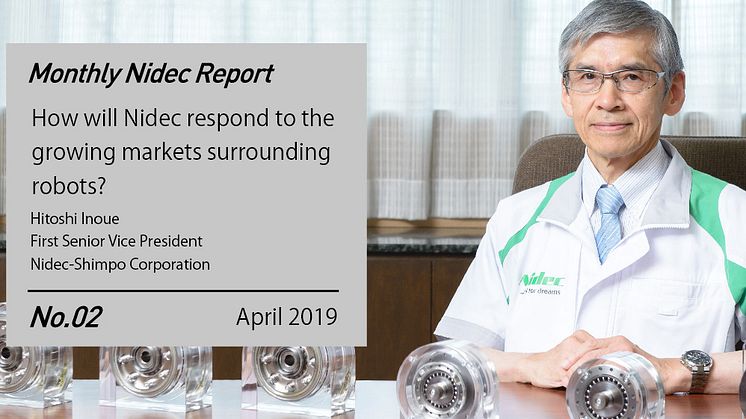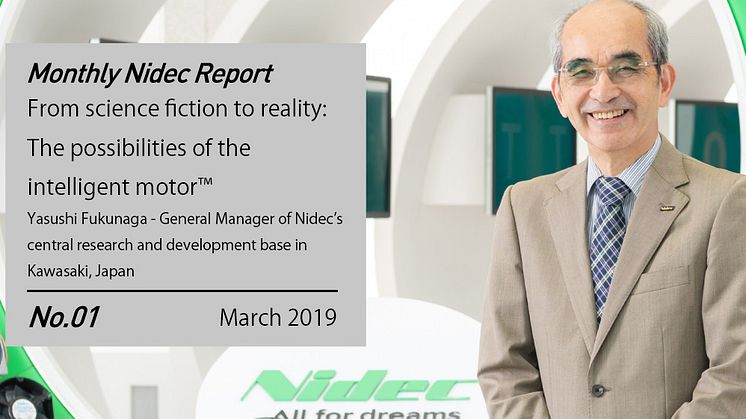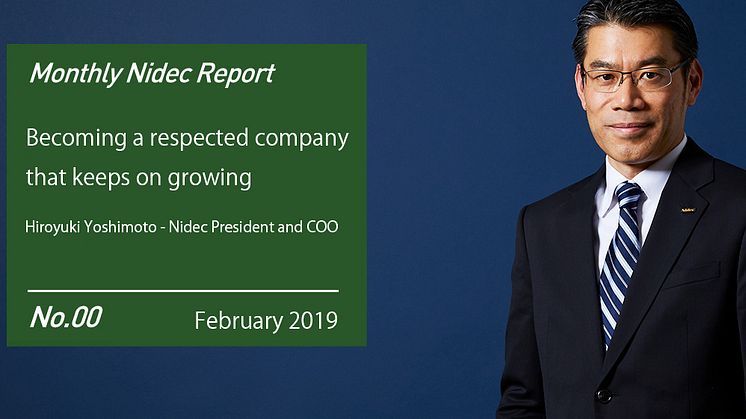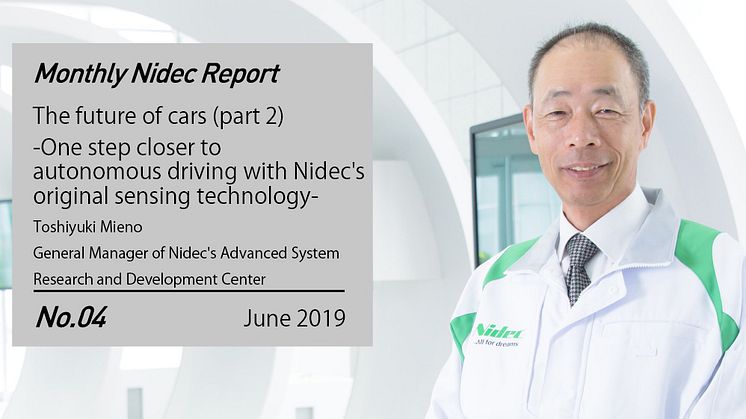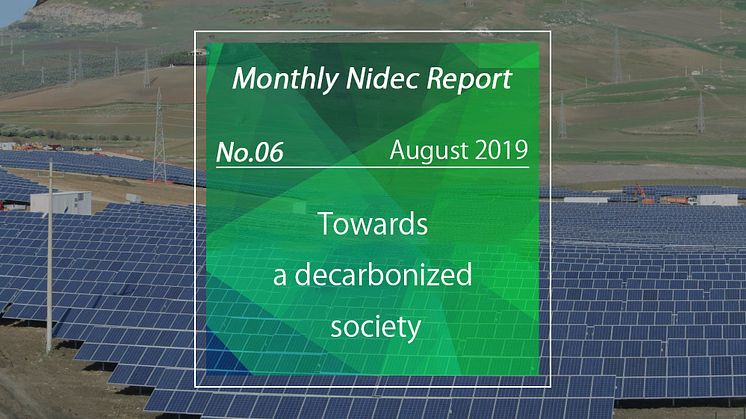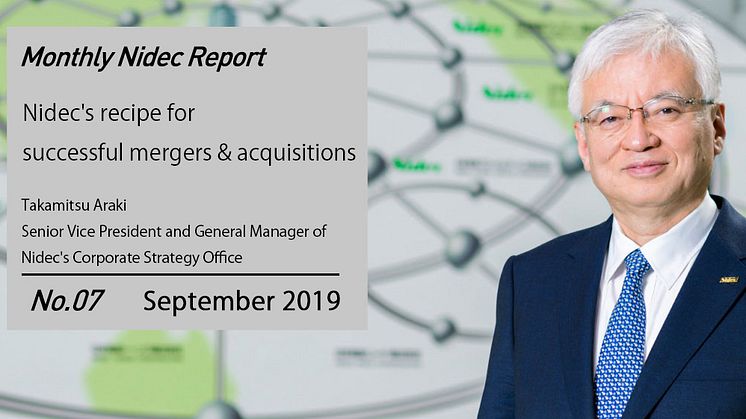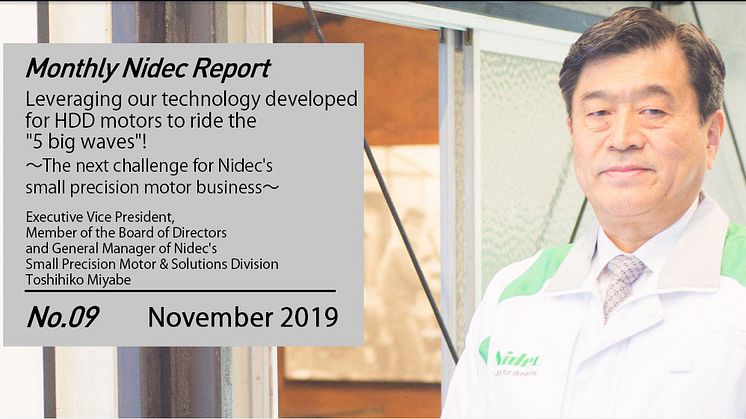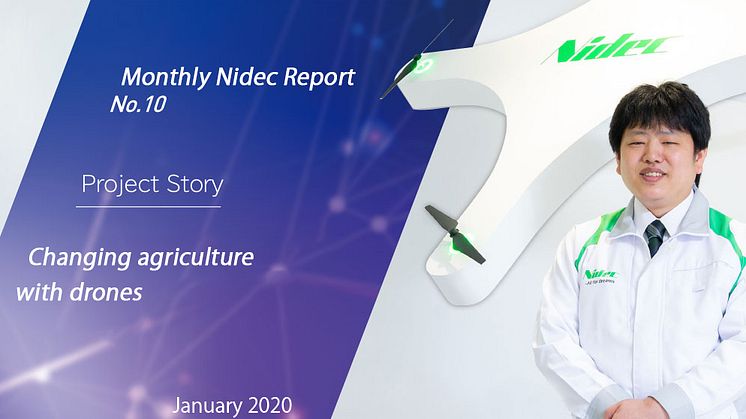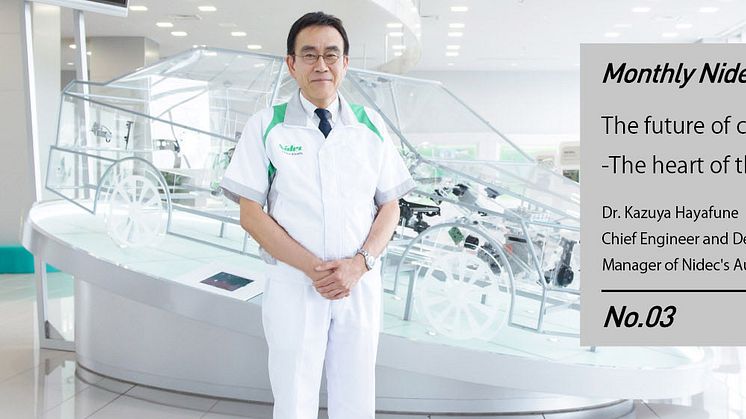
Blog post -
Monthly Nidec Report - The heart of the electric vehicle
As the electrification of automobiles rapidly progresses, Nidec is strengthening its presence in the industry. Recently, the company made its entry into the market for automotive traction motors—a key component at the core of fully electric (EV) and plug-in-hybrid electric vehicles (PHEV)—with the E-Axle. This fully integrated traction motor system that combines an electric motor, gears and an inverter into one unit, was designed by leveraging the technological know-how that the company has developed through its business as the world’s No.1 comprehensive motor maker.
The rapidly progressing vehicle electrification spurred by energy and environmental issues

- Nidec's traction motor system (E-Axle), first announced in 2017, has been receiving a lot of attention recently. What is the story behind the development of this product?
It all relates to the biggest trend in the automobile industry: rapidly progressing vehicle electrification. This trend, that has been called a once-in-a-hundred-years technological revolution, has an impact both on subsystems like electric power steering—an application that has traditionally been a strong point of Nidec—and, to an even greater extent, on main systems like the power train. In particular, I am talking about the transition from internal combustion engines to electric motors. The recent shift towards fully electric (EV) and plug-in-hybrid electric vehicles (PHEV) has been picking up pace globally since about three years ago. Approximately 1.3M EVs and PHEVs were sold globally in 2017 and current estimates predict that this number will grow to 12M in 2025. This increase is primarily driven by global energy and environmental issues. The world is facing environmental problems like global warming due to carbon dioxide emissions and air pollution caused by exhaust gas from automobiles, and these problems require that we move away from fossil fuel and start using clean cars that do not emit carbon dioxide or other harmful substances. Environmental regulations are tightening, especially in Europe but also in China and the US, as the spread of EVs is being promoted globally. For example, new passenger cars in Europe are required to stay below 130 g CO2/km, but in 2021 this limit will become 95 g CO2/km. Manufacturers that fail to comply will have to pay a penalty of €95 per registered car for each g/km of exceedance. This means that automakers have to make serious efforts to electrify their fleets, lest they risk falling by the wayside. For this reason, the demand for traction motors is increasing rapidly.
- How long have you been developing traction motor systems? Did you start recently?
Actually, we made our first attempt in around 2010. It has been evident for quite some time that vehicle electrification would eventually become a major trend. In 2010, we acquired a motor business from the American company Emerson Electric and their product portfolio included traction motors for commercial vehicles and construction machines. At the time, the price of rare earth material used to manufacture motor magnets was skyrocketing, so many people were placing their hopes in magnetless switched reluctance motors as an alternative solution, and the business that we acquired was a world leader in this area in terms of technology, with many patents. Thus, we developed a traction motor based on this technology and then went on to approach automakers and tier 1 suppliers all around the world. I, myself, visited many major European companies and strenuously tried convincing them to use our product. But unfortunately we didn’t get any orders. Looking back, we were too early; the big wave of vehicle electrification had not reached the shore yet; environmental regulations were still not a major concern for carmakers at the time, so only some models required traction motors, and due to limited volumes everyone produced their motors in-house. The fact that we were new to this field and didn’t have a track record yet also made things difficult as a lot of importance is placed on experience in the automobile industry; wherever you go you will be met with the question “do you have any previous experience with this type of product?” Everyone has to start somewhere though. For these reasons, we ended up postponing our entry to the traction motor market for the time being.
An opportunity brought about by a once-in-a-hundred-years technological revolution
- What made you take the decision to try again? Did you feel like your prospects had improved?
Exactly. Starting in about 2016, automakers and tier 1 suppliers experienced a paradigm shift due to the environmental regulations that I mentioned earlier. No longer would it be enough to offer just a couple of electric models; now entire fleets, from compact cars to large-size automobiles, would have to be electrified. It would no longer be possible to completely cover the need for electric traction motors with in-house production. Although motors for flagship models and luxury vehicles are still largely developed by the carmakers themselves, it has become more and more evident that many of companies are seeking to rely on outside suppliers for the motors that power their other models. For us, this is a great opportunity.
Taking the step towards traction motors is important not only because it lets us expand our automotive business, but also in terms of impact on employee motivation. Although we already have an extensive lineup of automotive motors—electric power steering motors, dual clutch transmission motors and engine cooling fan motors to name a few—that contribute quite a bit to the revenue and profit of the Nidec group, you can't really call yourself a true "manufacturer of automotive motors" unless you offer the heart of the electric vehicle: traction motors. A traction motor is to an EV what an engine is to a gasoline-powered car: the most important component. Employee motivation changes by a factor of 100 depending on whether we can offer traction motors or not.
Three components integrated into one unit—a result of the combined capabilities of the Nidec group
- What are the features of the E-Axle?
The defining feature of our traction motor system is its integrated design. The three main components—the electric motor, the inverter and the gears—have been combined into a single package. We call this the "three-in-one" design. Since all of the necessary drive components are gathered in one product, this is all you need to make your car run. Also, the integrated design makes for a light and compact product so there is more flexibility in terms of layout.
Of course, it’s not a matter of just attaching three components to each other and calling it a day; we are using some really advanced technology to integrate everything into one package. The idea itself of integrating the motor, inverter and gears isn't a new one, but it is very challenging in terms of technology so it took a while before it became reality. In particular, integrating the inverter, which is a delicate electronic components, with the electric motor, that vibrates as it rotates, is extremely difficult.
We were able to overcome these hurdles by combining the know-how of Nidec's automotive business unit and two of our subsidiaries, Nidec Elesys and Nidec Tosok—each with their own field of expertise. Nidec has the motor and the gears, Nidec Elesys has the inverter, and Nidec Tosok coordinates everything based on their know-how of power train technology. We all came together into one team.
We design and produce pretty much all components in-house. For the motor, in particular, even the initial steps in the manufacturing process—casting, machining, presswork and resin molding—are done in-house by Nidec group companies. In other words, as long as we have the necessary raw materials like the right metals and magnet material, we can manufacture our motors. And, with a total of over 3 billion electric motors produced every year for all kinds of fields and applications, we've achieved an economy of scale that lets us procure material and produce reliable high-quality products at a very low cost. This vertical integration lets us steer clear of various supply chain issues and guarantee stable supply of our products.

- What is your competitive advantage?
Our E-Axle is remarkably compact and lightweight. This is a significant advantage as it means that it only takes up about half as much space as a competing product with a similar output. In fact, our E-Axle is so small that many of our customers find it hard to believe us at first (Hayafune said with a laugh [editor's note]).
The key to making this possible is our know-how related to the design of magnetic circuits that we have built up over the years through our small precision motor businesses such as our HDD motor products. We also make full use of computer-aided engineering software to thoroughly simulate different designs so that we can remove excess material and make the motors as small as possible while keeping the same output. This is one of the strong points of our development capabilities and we use the same technique not only for our E-Axle but also for our electric power steering motors etc. Our automotive motors truly are the most compact in the industry.
 When downsizing a high-output motor like a traction motor, you encounter various new issues that you haven't faced before. One of these is heat. Our motor has a very high efficiency—96% (i.e. an energy loss of 4%)—but when you are working with outputs as high as 150 kW even highly efficient motors produce a lot of heat. What’s more, the small surface area due to the compact design makes thermal management even more challenging. We overcame this problem by developing a new oil-based cooling system. With the help of this proprietary oil-cooling system, we can remove excess heat, which makes it possible for us to design very compact high-output motors that stay inside certain temperature ranges. |

Nidec's large-scale traction motor system factory in China
- What are your plans for the future?
China is being focused on as the new center of the market for electric vehicles. Recently, we finished construction of a new large-scale factory in the Pinghu Economic Development Zone in China. The large 66,000 m2 factory dedicated to the production of traction motor systems occupies a large piece of land in the area. We've had many potential customers approach us since we announced the E-Axle and we have already started producing motors based on an order received from a Chinese automaker. At the same time, we are actively approaching other Chinese, Japanese, European and Korean automobile manufacturers, among others, in search of new business opportunities.

- So you finally have your own track record in the traction motor business?
That's correct! The more successful projects we have under our belt, the smoother things will go when we talk business with new customers. Moving forward, we want to expand our lineup so that we can offer stand-alone traction motors to customers that want to combine our motors with gears or inverters developed separately by tier 1 suppliers.
Many Chinese automakers do not have the technological experience necessary to develop their own traction motor systems and thus do not mind sourcing them from outside suppliers. Therefore, they buy whole systems. Also, they aren’t intertwined with European and American tier 1 suppliers so there are plenty of business opportunities for newcomers like us as well. If everything goes according to plan, we can continue building on our track record by mass producing and selling in China, and then leverage this experience to break into the global market. European and American carmakers, on the other hand, are capable of producing their own traction motor systems in-house and have longstanding relationships of trust with established tier 1 suppliers. Because of this, there is a tendency for these carmakers to source their traction motor systems from tier 1 companies whom they are already affiliated with. Thus, we end up receiving orders for stand-alone motors from tier 1 suppliers instead in these markets. As there are very few tier 1 suppliers that specialize in electric motors, we are in a very advantageous position in this respect. Even if we are unable to receive orders for complete systems from some automobile manufacturers, we do receive orders for stand-alone motors. The end result will be the same: eventually our electric motors will end up powering many automobiles.

Traction motors as Nidec's new growth engine
- Finally, what are your medium- to long-term prospects for your automotive business as a whole?
Our automotive business is centered on a couple of major products—one of them being our family of electric power steering motors. Currently, our electric power steering motors account for 30% of the entire global market, but we are working to further expand our position and our goal is to reach 50% by the end of FY2020. Another important product category is next-generation brake motors. Next-gen brakes work by sending an electronic signal to a motor that applies braking force to the wheels. The signal carries information about how much, and how quickly, the brake pedal is depressed. There are great benefits to this technology. For example, braking force can be applied instantly in emergency situations to reduce accidents, and it becomes easier to precisely control the brakes when driving autonomously. In the near future, all cars, gasoline-powered vehicles included, are expected to switch over to this technology. Fortunately for us, the same motors that are used in electric power steering systems can be used for this application as well. Since we can use our top-market-share motor as it is, we can supply a high-quality product in large volumes at low prices. The motor is well received by all automakers so our goal is to continue expanding our position, capture 60% of the global market, and become No. 1 in this field as well.
Based on a strategy chiefly revolving around these products, we aim to grow our automotive business to JPY 700 billion - 1 trillion by the end of FY2020. The figure for FY2017 is JPY 295.4 billion.
In FY2020, traction motors will still only make up a relatively small portion of the total revenue of our automotive business, but, as I have explained, demand is expected to grow significantly. In 2025, I expect that they will have become a driving force for our automotive business.
Looking further into the future, we have set a goal for the combined revenue of all our businesses to reach JPY 10 trillion in FY2030. In this context, it will be necessary for us to grow our automotive business to JPY 4 trillion by then, and I believe that the growth of our traction motor business will be key to achieving this.
I envision a future where the electric power steering motors and next-gen brake motors that I mentioned earlier together with traction motors make up the three cornerstones that drive the growth of our automotive business.
